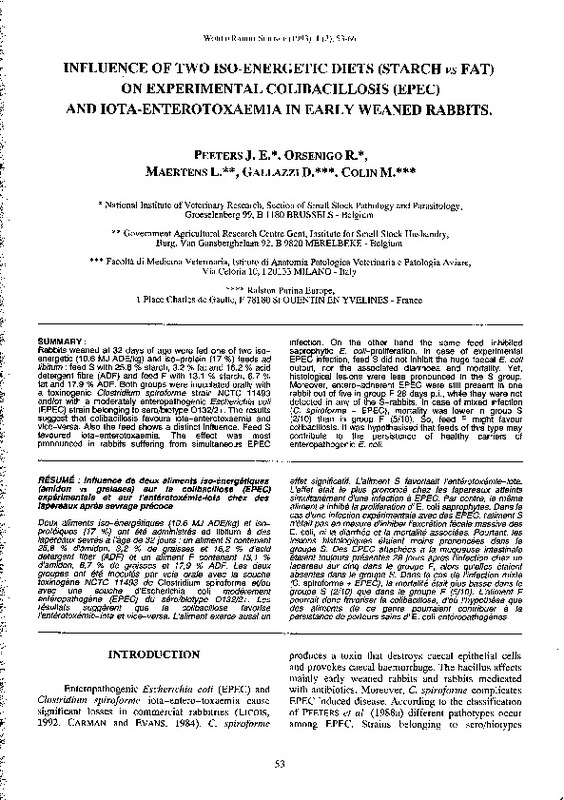|
Resumen:
|
[EN] Rabbíts weaned at 32 days of age were fed one of two isoenergetic
(10.6 MJ ADE/kg) and iso-protein (17 %) feeds ad
libitum: feed S with 25.8 % starch, 3.2 % fat and 16.2 % acid
detergent fibre (ADF) and feed F with ...[+]
[EN] Rabbíts weaned at 32 days of age were fed one of two isoenergetic
(10.6 MJ ADE/kg) and iso-protein (17 %) feeds ad
libitum: feed S with 25.8 % starch, 3.2 % fat and 16.2 % acid
detergent fibre (ADF) and feed F with 13.1 % starch, 6. 7 %
fat and 17.9 % ADF. Both groups were inoculated orally with
a toxinogenic Clostridium spiroforme strain NCTC 11493
and/or with a moderately enteropathogenic Escherichia coli
(EPEC) strain belonging to sero/biotype 0132/2+. The results
suggest that colibacillosis favours iota-enterotoxaemia and
vice-versa. Also the feed shows a distinct influence. Feed S
favoured iota-enterotoxaemia. The effect was most
pronounced in rabbits suffering from simultaneous EPEC infection. On the other hand the same feed inhibited
saprophytic E. co/i-proliferation. In case of experimental
EPEC infection, feed S did not inhibit the huge faecal E. coli
output, nor the associated diarrhoea and mortality. Yet,
histological lesions were less pronounced in the S-group.
Moreover, entero-adherent EPEC were still present in one
rabbit out of five in group F 28 days p.i., while they were not
detectad in any of the S-rabbits. In case of mixed infection
(C. spiroforme + EPEC), mortality was lower in group S
(2/10) than in group F (5/10). So, feed F might favour
colibacillosis. lt was hypothesised that feeds of this type may
contribute to the persistence of healthy carriers of
enteropathogenic E. coli.
[-]
[FR] Deux aliments iso-énergétiques (10.6 MJ ADE/kg) et isoprotéiques
(17 %) ont été administrés ad libitum a des
lapereaux sevrés a /'age de 32 jours : un aliment S contenant
25,8 % d'amidon, 3,2 % de graisses et 16,2 ...[+]
[FR] Deux aliments iso-énergétiques (10.6 MJ ADE/kg) et isoprotéiques
(17 %) ont été administrés ad libitum a des
lapereaux sevrés a /'age de 32 jours : un aliment S contenant
25,8 % d'amidon, 3,2 % de graisses et 16,2 % d'acid
detergent fiber (ADF) et un aliment F contenant 13, 1 %
d'amidon, 6, 7 % de graisses et 17,9 % ADF. Les deux
groupes ont été inoculés par voie ora/e avec la souche
toxinogene NCTC 11493 de Clostridium spiroforme et/ou
avec une souche d'Escherichia coli modérement
entéropathogene (EPEC) du séro/biotype 0132/2+. Les
résultats suggerent que la colibacillose favorise
l'entérotoxémie-iota et vice-versa. L'aliment exerce aussi un effet significatif. L'aliment S favorisait l'entérotoxémie-iota.
L 'effet était le plus prononcé chez les lapereaux atteints
simultanément d'une infection a EPEC. Par contre, le meme
alimenta inhibé la prolifération d' E. coli saprophytes. Dans le
cas d'une infection expérimentale avec des EPEC, l'aliment S
n'était pasen mesure d'inhiber l'excrétion fécale massive des
E. coli, ni la diarrhée et la mortalité associées. Pourtant, les
lésions histologiques étaient moins prononcées dans le
groupe S. Des EPEC attachées a la muqueuse intestina/e
étaient toujours présentes 28 jours apres l'infection chez un
lapereau sur cinq dans le groupe F, alors qu'elles étaient
absentes dans le groupe S. Dans le cas de l'infection mixte
(C. spiroforme + EPEC), la mortalité était plus basse dans le
groupe S (2/10) que dans le groupe F (5/10). L'aliment F
pourrait done favoriser la colibacillose, d'ou l'hypothese que
des aliments de ce genre pourraient contribuer a la
persistance de porteurs sains d' E. coli entéropathogenes.
[-]
|








